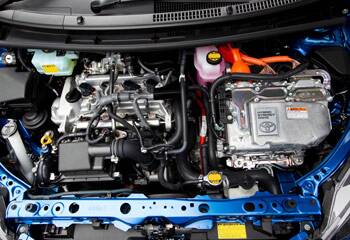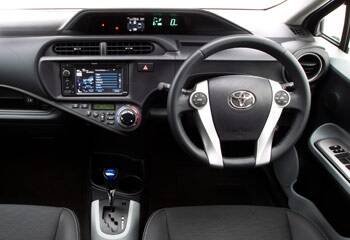Honey, they shrunk the Prius. And the price. Hybrid driving gets a cheaper entry level with the launch of the Toyota Prius C.
The new arrival undercuts the current price champ – Honda’s Insight – by $6000. And it also hopes to cut back a slice of the Insight’s market too. Last year the Honda sold 715 Insights – about the same number of sales the existing Prius dropped.
The new arrival will target Gen-Y buyers, who are expected by Toyota to push up hybrid sales. That expectation is made on the basis of the Prius C’s fuel economy and cheaper hybrid entry price. But we can’t help wondering if Gen-Y – happy to splash any amount of ransom demanded for the latest i-Thing (and then more again for the next one) – is swayed by such practical considerations.
VALUE
The Prius C starts at $23,990 for the base model, with a standard list that includes all the expected electronic necessities of city life – including the almost-mandatory touchscreen and music/phone streaming.
An extra $3000 puts you in the higher-spec Prius C i-Tech, which adds better quality upholstery, satnav with live traffic alerts, alloy wheels, self-levelling LED headlights, retractable side mirrors and – presumably for purely cosmetic purposes – a larger rear spoiler.
Toyota cites the Insight as a target, but any practical buyer would measure the Prius C against other city cars – and there are many good ones that cost less. From a little to a lot less.
Toyota’s own Yaris, and the Kia Rio, Mazda2, Suzuki Swift, Ford Fiesta and Volkswagen Polo ranges all offer variants with good combinations of engine, transmission and fit-out for the urban run.
Yes, some people will be attracted to the planet-saving promise of the hybrid’s lower tailpipe emissions. But the main argument for most hybrid buyers is the vision of a future where fuel is not going to get any cheaper – and where a couple of extra thousand dollars now will save more in the long term.
 TECHNOLOGY
TECHNOLOGY
The Prius-derived drivetrain uses a 54kW/111Nm 1.5-litre four-cylinder petrol engine in tandem with a 45kW/169Nm electric motor to produce a total of 74kW of power. An electronically controlled CVT auto transmission drives the front wheels, and a regenerative system captures brake energy to feed charge to the battery – still the older (and cheaper) nickel-metal hydride unit rather than lighter and more efficient lithium-ion. Toyota promises the newer battery technology will arrive in a future Prius. But not this one.
Despite being a smaller engine in a smaller car, the system has to work harder, so the fuel figures are not hugely improved over the Prius. The official numbers are 0.2 litres better at 3.7 litres/100km on the city cycle but a Prius-matching 3.9 litres/100km on the combined cycle (and CO2 emissions slightly dirtier at 90 grams/km).
You can get a couple of kilometres solely on the electric motor, but after that the car will switch back to the engine. An initially confusing – although blaringly colourful -- set of pages for the in-dash trip computer screen gives you the all expected information plus a plethora more related to the hybrid operation.
This includes how much money you are spending based on the fuel price data you enter, and how greenly you’ve been driving, giving you a score out of 100. We appeared to be only tightly tinged with eco-colour, finishing with a mark off 22 after a long stretch of what we’d consider normal driving.
SAFETY
Prius C gets seven airbags, reversing camera, vehicle stability and traction control, anti-skid brakes with brake assist and electronic brakeforce distribution, and hill-start assist control. It hasn’t been ANCAP tested but Toyota says it should get a five-star safety rating.
DESIGN
The mini-Prius look works to remarkably good effect. Yes, there’s a reasonable family resemblance, but the Prius C – based on the Yaris platform -- looks sharper and more modern than its hybrid signature ancestor. The looks are helped by it sitting lower, but it’s also shorter, narrower and 285kg lighter.
Space has been well-packaged, which gives more rear legroom than the Yaris and Corolla, although it’s still difficult for longer legs in the back. The positioning of the battery and fuel tank under the rear seat means there’s less compromise on luggage space, and – yes – a full-size spare wheel. And folding the rear seat gives a another boost of functional space to the 260 litres.
More importantly for city drivers, the turning circle is a tight 4.8 metres. And perhaps most importantly for the target market, it has 17 pockets, bins and holders for all the tech and detritus storage anybody could wish. The flat-bottomed steering wheel has hints of sport, but its only benefit is to lift the looks and offer marginally better access for sliding into the driver’s seat.
 DRIVING
DRIVING
The initial impression of the Prius C is of a pleasant and undemanding city car. Exactly what it is, in fact. The cabin is fairly hushed except for tyre noise, and the ride is firm but comfortable – it soaks up bumps and broken bitumen brilliantly, which holds promise for negotiating some of Australia’s appalling street surfaces.
We didn’t expect the drivetrain to be a cracker, and that was spot on. It tootled around quite well, but complained noisily when asked to punt up hills. Performance was okay off the line, but the momentum tended to flatten out after that. We managed seven seconds to hit 60km/h, but then another nine to move from there to the 100km/h mark.
Calibrated for city streets, the steering is light and feels artificial. Similarly, the continuously variable transmission is smooth and simply drones along quietly, but could be almost non-existent in terms of effort. We badly felt the need for a faux-manual mode, or anything that would prove the presence of a transmission, but the target market probably won’t care.
What they will care about – if Toyota is right about Gen-Me being the Prius C’s main buyer pool – is that the interior experience doesn’t offer enough bling and dazzle. The design is fairly clean but in no way funky. And buyers looking for style sizzle while still wanting vegan sausage will be disappointed.
The exterior has the looks, but the interior – where they’ll spend hours stuck in city traffic – feels old hat, despite the clever animations on the trip computer screen and the base model’s aqua plastic strip accents. If Gen-Y is truly the hybrid sales saviour, they’re likely to look more at what is in the cabin than what’s under the bonnet. And that could leave them looking for more.
VERDICT
It’s a good little thing for the city, but there are plenty of other good city cars. For ordinary drivers, the main question of whether or not to buy it should measure the price against the fuel saving.
TOYOTA PRIUS C
Price: from $23,990
Warranty: 3 years/100,000km, 8 years/160,000 km on battery
Resale: NA
Service intervals: 10,000km/six months
Thirst: 3.9 litres/100km (official), 91RON, 90g/km CO2
Crash rating: Five-star (est)
Safety equipment: seven airbags, (ABS, BA, EBD, stability and traction control
Engine: 1.5-litre four-cylinder engine + 45kW electric motor, 74kW/111Nm total
Transmission: electronic CVT auto, FWD
Body: Five-door hatch
Dimensions: 3995mm (L), 1695mm (W), 1455mm (H), 2550mm (WB), 1465mm/1460mm tracks front/rear
Weight: 1120kg-1140kg
Tyre size: 15 x 5.5
Spare tyre: full-size
Toyota Prius C 2012:
| Engine Type | Inline 4, 1.5L |
|---|---|
| Fuel Type | Unleaded Petrol/Electric |
| Fuel Efficiency | 3.9L/100km (combined) |
| Seating | 5 |
| Price From | $8,470 - $11,880 |
| Safety Rating |
|
Pricing Guides

Range and Specs
| Vehicle | Specs | Price* |
|---|---|---|
| Base | 1.5L, Unleaded Petrol/Electric, SPEED CONTINUOUS VARIABLE | $8,470 - $11,880 |
| I-Tech | 1.5L, Unleaded Petrol/Electric, SPEED CONTINUOUS VARIABLE | $9,790 - $13,420 |





















































































